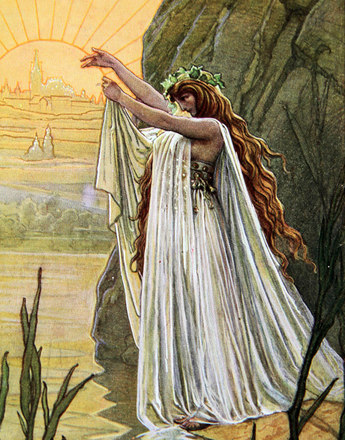-

“Massacre of the nobles in Galicia”, illustration, 19th century
Copyright: Schloß Schönbrunn Kultur-und Betriebsges.m.b.H./Fotograf: Alexander E. Koller
-

Roman Kochanowski: The Vavel, the Royal Castle in Kraków, illustration
Copyright: Schloß Schönbrunn Kultur-und Betriebsges.m.b.H./Fotograf: Alexander E. Koller
The first words of the Polish national anthem call out the hopes of the Poles to regain their freedom. Poland foundered as a nation because of the Polish Partitions in the late eighteenth century, when the neighbouring Great Powers of Prussia, Russia and Austria partitioned the territory of the Polish aristocratic republic between them.
Jeszcze Polska nie zginęła,
Kiedy my żyjemy.
Co nam obca przemoc wzięła,
Szablą odbierzemy.
Translation:
Poland is not yet lost,
as long as we live.
We shall win back with the sword
what foreign tyranny took from us.
The Polish national anthem was composed in 1797 as a battle song of the Polish Army in Exile in Italy.
Although vanished from the map, the idea of an autonomous national existence was always very much alive among the Poles. They lived for the idea of a “virtual” Polish state, whose élite had fled to exile and worked there for a re-establishment of a free Poland. Polish troop contingents for instance fought on the side of Napoleon’s armies against Austrians and Russians. The close political and cultural connections to France are explained by the hope of the solidarity of the French revolutionaries for the Polish cause. Napoleon ultimately resurrected Poland for a brief period in the form of the Grand Duchy of Warsaw.
However, the Congress of Vienna perpetuated the partition of Poland: the south became part of the Austrian Empire and titled Kingdom of Galicia and Lodomeria, the west fell to Prussia and the east to Russia. Central Poland was given a special status together with Warsaw and became a Russian satellite state as Congress Poland. Solely Krakow remained a city state (Republic of Krakow), formally independent, but actually a protectorate of Prussia, Russia and Austria.
The main pillar of Polish national identity was embodied in the extraordinarily numerous Polish petty aristocracy (szłachta) committed to historical Poland, while the mass of the rural population remained indifferent to the national cause and remained excluded from all say in political matters.
The dream was the re-establishment of the historical greater Polish empire, which covered widespread parts of Eastern Europe from the Baltic to Ukraine. The Poles claimed the leading role in this territory for themselves, although the historical kingdom was a multi-ethnic configuration. The Poles saw themselves as ambassadors of culture to the peoples of northeastern Europe and “Shield of Christendom” against Tatar and Turkish invaders from the east. A special role was played by the Catholic Church, at first as demarcation against the Orthodox Slavic neighbours of Russians, White Russians and Ukrainians, also against Protestant Germans. Later it took on the function as conservator of Polish national identity at a time when Poland had foundered as a state.
Vienna and Berlin often sensed the danger of Pan-Slavism in the continued endeavours of the Poles to regain their independence. Yet Polish-Russian relations were tense, because the Poles saw the Tsarist empire as an occupying force and a great obstacle to consensus. Moreover, the Russian powers-that-be violently repressed national Polish agitation. Thus the Polish revolt which broke out in 1830/31 in the Russian-controlled parts of Poland was brutally crushed. It was a bitterly sobering blow for the Russophiles among the Slavs of Central Europe.
Confronted by the endeavours to re-unite, Vienna, too, began to see the Poles as firebrands. The Viennese Government exploited the social and nationalist conflict potential in Galicia and responded to Polish secessionism according to the principle “Divide and rule!”, they reinforced their compliance to the demands of the Ruthenians.
In 1846 Austrian Galicia was shaken by an uprising that had at first begun as a national-Polish revolt (”Krakow Revolt”). The situation worsened when the subservient rural population turned against their Polish landlords and their blind rage against the oppressors escalated into bloody carnage. The Austrian administration watched passively, ultimately profiting from the collapse of the secessionist endeavours backed by the Polish aristocracy. A further consequence of the failure of the aristocratic revolt was Austria’s occupation and annexation of the Free Republic of Krakow.
Translation: Abigail Prohaska
Batowski, Henryk: Die Polen, in: Wandruszka, Adam/Urbanitsch, Peter (Hrsg.): Die Habsburgermonarchie 1848–1918, Band III: Die Völker des Reiches, Wien 1980, Teilband 1, 522–554
Hoensch, Jörg K.: Geschichte Polens. (3. Auflage), Stuttgart 1998
Křen, Jan: Dvě století střední Evropy [Zwei Jahrhunderte Mitteleuropas], Praha 2005
Rumpler, Helmut: Eine Chance für Mitteleuropa. Bürgerliche Emanzipation und Staatsverfall in der Habsburgermonarchie [Österreichische Geschichte 1804–1914, hrsg. von Herwig Wolfram], Wien 2005
-
Chapters
- Poles and Ruthenians in the Habsburg Monarchy
- At the Margins of the Empire: Galicia and Bukovina
- The struggle of the Poles for their nation: Poland is not yet lost!
- Compromise with Vienna: Polish Autonomy in Galicia
- The Poles in the First World War: a Nation as Football for the Great Powers
- The Great Unknown: The Ruthenians
- Approach and Rejection: The Ruthenians between Austria and Russia



